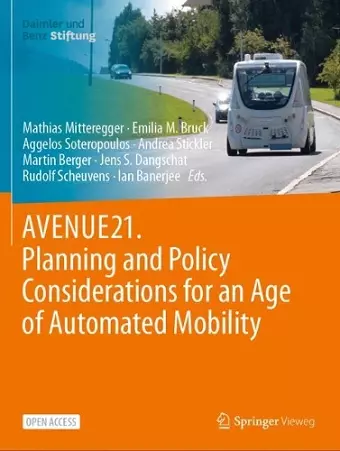AVENUE21. Planning and Policy Considerations for an Age of Automated Mobility
Martin Berger editor Mathias Mitteregger editor Emilia M Bruck editor Aggelos Soteropoulos editor Andrea Stickler editor Jens S Dangschat editor Rudolf Scheuvens editor Ian Banerjee editor
Format:Paperback
Publisher:Springer Fachmedien Wiesbaden
Published:30th Mar '23
Currently unavailable, and unfortunately no date known when it will be back
This paperback is available in another edition too:
- Hardback£44.99(9783662670033)

The subject of this open-access publication is the impact of connected and automated vehicles on the European city and the conditions under which this technology can make a positive contribution to urban development. The authors put forward two theses that have received little attention in the scientific discourse so far: Connected and automated vehicles will not become fully established in all sub-areas of the city for a long time. As a result, previously assumed effects - from traffic safety to traffic performance as well as spatial effects - will have to be reevaluated.
To ensure a positive contribution of this technology to the mobility of the future, transport and settlement policy regulations must be further developed. Established territorial, institutional and organizational boundaries need to be challenged in a timely manner.
Despite or because of the existing great uncertainties, we are at the beginning of a phase of yet shaping the possible future - in technology development, but also in politics, urban planning, administration and civil society.
Description of the chapters:
1. Connected and automated driving: The long level 4
Mathias Mitteregger reflects on the road ahead for automated driving. What pathways of technological development induce which kind of spatial effects and planning needs?
2. Connected and automated driving: Consideration of the local, spatial context and spatial differentiation
Emilia M. Bruck and Aggelos Soteropoulos reflect on the importance of the local context when classifying and estimating the effects of different forms of automated mobility.3. Connected and automated driving in the context of a sustainable transport and mobility transformation
Andrea Stickler, Jens S. Dangschat and Ian Banerjee integrate possible potentials of automated mobility in the contextof a transformed, sustainable transport system.
PART I: Mobility and transport
4. Self-driving turnaround or automotive continuity? Reflections on technology, innovation and social change
Katharina Manderscheid reflects on how differing visions of an automated future can be understood with regard to divergent interests in technological development.
5. Automated drivability and streetscape compatibility in the urban-rural continuum using the example of Greater Vienna
Aggelos Soteropoulos analyses how different street spaces align with technological requirements of automated mobility, creating a suitability framework for road spaces in the Greater Vienna region.6. Automation, public transport and Mobility as a Service: Experience...
ISBN: 9783662670064
Dimensions: unknown
Weight: unknown
460 pages
1st ed. 2023